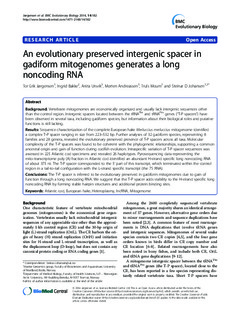| dc.contributor.author | Jørgensen, Tor Erik | |
| dc.contributor.author | Bakke, Ingrid | |
| dc.contributor.author | Ursvik, anita | |
| dc.contributor.author | Andreassen, morten | |
| dc.contributor.author | Moum, Truls | |
| dc.contributor.author | Johansen, Steinar Daae | |
| dc.date.accessioned | 2015-01-19T13:54:22Z | |
| dc.date.accessioned | 2015-02-10T12:45:19Z | |
| dc.date.available | 2015-01-19T13:54:22Z | |
| dc.date.available | 2015-02-10T12:45:19Z | |
| dc.date.issued | 2014 | |
| dc.identifier.citation | BMC Evolutionary Biology 2014, 14:182 | nb_NO |
| dc.identifier.issn | 1471-2148 | |
| dc.identifier.uri | http://hdl.handle.net/11250/275754 | |
| dc.description | The electronic version of this article is the complete one and can be found online at: http://www.biomedcentral.com/1471-2148/14/182 | nb_NO |
| dc.description.abstract | Background: Vertebrate mitogenomes are economically organized and usually lack intergenic sequences other than the control region. Intergenic spacers located between the tRNAThr and tRNAPro genes (“T-P spacers”) have been observed in several taxa, including gadiform species, but information about their biological roles and putative functions is still lacking.
Results: Sequence characterization of the complete European hake Merluccius merluccius mitogenome identified a complex T-P spacer ranging in size from 223–532 bp. Further analyses of 32 gadiform species, representing 8 families and 28 genera, revealed the evolutionary preserved presence of T-P spacers across all taxa. Molecular complexity of the T-P spacers was found to be coherent with the phylogenetic relationships, supporting a common ancestral origin and gain of function during codfish evolution. Intraspecific variation of T-P spacer sequences was assessed in 225 Atlantic cod specimens and revealed 26 haplotypes. Pyrosequencing data representing the mito-transcriptome poly (A) fraction in Atlantic cod identified an abundant H-strand specific long noncoding RNA of about 375 nt. The T-P spacer corresponded to the 5’ part of this transcript, which terminated within the control region in a tail-to-tail configuration with the L-strand specific transcript (the 7S RNA).
Conclusions: The T-P spacer is inferred to be evolutionary preserved in gadiform mitogenomes due to gain of function through a long noncoding RNA. We suggest that the T-P spacer adds stability to the H-strand specific long noncoding RNA by forming stable hairpin structures and additional protein binding sites. | nb_NO |
| dc.language.iso | eng | nb_NO |
| dc.publisher | BioMed Central | nb_NO |
| dc.title | An evolutionary preserved intergenic spacer in gadiform mitogenomes generates a long noncoding RNA | nb_NO |
| dc.type | Journal article | nb_NO |
| dc.type | Peer reviewed | en_GB |
| dc.date.updated | 2015-01-19T13:54:22Z | |
| dc.source.volume | 14 | nb_NO |
| dc.source.journal | BMC Evolutionary Biology | nb_NO |
| dc.identifier.doi | 10.1186/s12862-014-0182-3 | |
| dc.identifier.cristin | 1157303 | |
| dc.description.localcode | Forlagets publiserte versjon. Open access. © 2014 Jørgensen et al.; licensee BioMed Central Ltd.This is an Open Access article distributed under the terms of the Creative Commons Attribution License (http://creativecommons.org/licenses/by/4.0), which permits unrestricted use, distribution, and reproduction in any medium, provided the original work is properly credited. The Creative Commons Public Domain Dedication waiver (http://creativecommons.org/publicdomain/zero/1.0/) applies to the data made available in this article, unless otherwise stated. | nb_NO |
